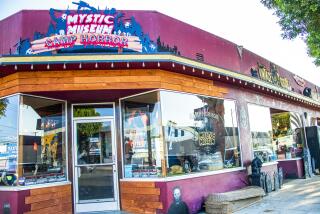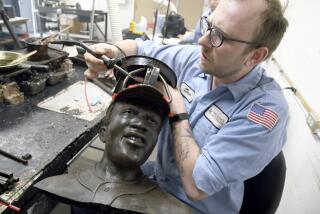Stolen Art Had No Theft Insurance : Museum: Some experts estimate the value of the articles taken at $200 million. Most agree the loss in Boston is one of the largest in history.
BOSTON — A dozen priceless works of art stolen from the Isabella Stewart Gardner Museum early Sunday morning were not insured against theft, a museum spokesman confirmed Monday.
“They were insured against damages,” said Barry Wanger, a spokesman for the collection housed in an Italianate villa. “But not against theft.”
FBI sources investigating the predawn theft of paintings and drawings by Rembrandt, Vermeer, Degas and others, as well as a Chinese beaker that dates from 1500 BC, called the break-in one of this country’s largest thefts ever of any kind.
With an estimated value of at least $200 million, the heist by a pair of robbers disguised as policemen was also believed to be among the largest art thefts in history.
But museum director Anne Hawley declined to attach a monetary value to the works stolen from a single gallery in the museum built by the widow of the wealthy son of Boston’s last East India shipping merchant.
“The material is priceless,” Hawley said. “There is no way to estimate the entire value.”
Calling the robbery “a barbaric act,” Hawley added: “Part of our heritage has been stolen from us.”
Using a side door to the museum, the thieves, both white males, apparently took advantage of a stepped-up police presence in the vicinity of the museum to help gain entrance. A surge in street crime has made uniformed police officers a common sight in recent months, Hawley said.
The thieves overpowered the two museum guards on duty just after 1 a.m. on Sunday, then bound and gagged them with duct tape and handcuffs. Paul Cavanagh, a spokesman for the FBI here, said the thieves disabled surveillance cameras before making their selections from the museum walls. The robbery was not discovered until about six hours later, when maintenance workers arrived.
Several of the paintings, including more than one of the three Rembrandts stolen, were cut from their frames, Karen Haas, the museum’s acting curator, said.
That fact was of great concern to Peter Sutton, the curator of European paintings at Boston’s Museum of Fine Arts. “Old paintings like that don’t bend,” Sutton said. “They snap.”
The thieves made off with a group of art works so carefully selected that “it would appear” that they had a shopping list, Hawley said. She said the works have such a high international profile that “only a person who is determined to keep them private for the rest of their life” could hold on to them.
Sutton, for one, discounted the suggestion that the theft’s mastermind might be some “deranged aesthete” with a hankering for the gems from the Gardner collection.
“It’s not even obvious to me that they chose the right paintings among them,” he said. He noted that the thieves had passed over a large Rembrandt self-portrait in the same room as well as a major work by Titian in an adjacent gallery.
Still, the robbery brought messages of sympathy and support to the Gardner from around the art world.
“We all reacted in a way as if children had been kidnaped,” said John Walsh, the director of the J. Paul Getty Museum in Los Angeles. “As when anything or anyone is kidnaped, your worst fear is that they will be destroyed.”
Earl A. Powell III, the director of the Los Angeles County Museum of Art, called the theft “a real loss to American museums if these works are not recovered.”
With both the FBI and Interpol pursuing the case, officials at the Gardner expressed confidence that the art works would be recovered.
Cavanagh, of the FBI, concurred, saying: “We expect (the works) to be located, but we’re not going to put ourselves on a timetable.”
No effort will be made to fill the empty spaces left by the stolen paintings when the museum reopens to visitors, Haas said. The will of Mrs. Gardner, who lived on the top floor of the museum until her death in 1924, was so specific that not one painting or object may be moved from the locations she selected.
Museum spokesman Wanger pointed out also that the provisions of the Gardner will further stipulate that “the museum cannot buy or substitute works of art,” rendering the question of replacement insurance “a nonissue.”
Known around Boston as “Mrs. Jack,” Isabella Stewart Gardner delighted in defying the rigid codes of high society in turn-of-the-century Boston. She walked a pet lion named Rex on a leash, drank beer instead of tea and for a portrait by John Singer Sargent wore a dress so revealing that her husband refused to allow the painting to be displayed. Told that everyone of any consequence in Boston was either an Episcopalian or a Unitarian, Mrs. Gardner became a Buddhist.
She took up construction of Fenway Court, as the museum was first known, as a hobby when she suffered a nervous breakdown after her husband died. With a foyer that includes a seat once occupied by the Emperor Nero and balconies and balustrades from 15th- and 16th-Century villas in Venice, the building was designed by William Sears, the same Boston architect who designed the Old South Church.
More to Read
The biggest entertainment stories
Get our big stories about Hollywood, film, television, music, arts, culture and more right in your inbox as soon as they publish.
You may occasionally receive promotional content from the Los Angeles Times.










